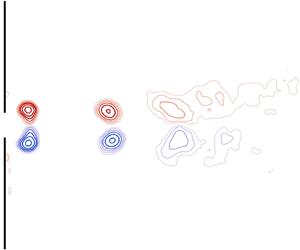Article contents
Vortex ring breakdown dominating the entrainment of a synthetic jet
Published online by Cambridge University Press: 26 January 2024
Abstract

The understanding of the entrainment mechanism of synthetic jets can help optimise the synthetic jet actuators in engineering applications. It is generally believed that vortex rings or strong velocity fluctuations in the near field of the synthetic jet are responsible for its enhanced entrainment. However, in recent years, it has been found that the enhanced entrainment of the synthetic jet may be caused by the instability or the vortex ring breakdown in the transition region. To shed new light on this issue, synthetic jets with different Reynolds numbers and dimensionless stroke lengths are investigated with time-resolved two-dimensional particle image velocimetry. Based on the analyses of velocity triple-decomposition, Fourier mode decomposition and phase-averaged  $\lambda _{ci}D/U_0$ field, the streamwise positions of the vortex ring breakdown are determined for the synthetic jets, and the entrainment coefficient can be divided into three components, i.e. the coherent turbulent kinetic energy production, the random turbulent kinetic energy production and the shape of the velocity profile. It is found that the entrainment coefficient is dominated by the component related to the random turbulent kinetic energy production, and reaches its peak value at the position of vortex ring breakdown. The results obtained in different cases show a strong correlation between vortex ring breakdown and entrainment enhancement. From the perspective of instantaneous snapshot, the mechanism of vortex ring breakdown enhanced entrainment is revealed, that is, vortex ring breakdown enhanced the small-scale vortex near the turbulent/non-turbulent interface, resulting in an increase of enstrophy production, and thus enhanced local entrainment.
$\lambda _{ci}D/U_0$ field, the streamwise positions of the vortex ring breakdown are determined for the synthetic jets, and the entrainment coefficient can be divided into three components, i.e. the coherent turbulent kinetic energy production, the random turbulent kinetic energy production and the shape of the velocity profile. It is found that the entrainment coefficient is dominated by the component related to the random turbulent kinetic energy production, and reaches its peak value at the position of vortex ring breakdown. The results obtained in different cases show a strong correlation between vortex ring breakdown and entrainment enhancement. From the perspective of instantaneous snapshot, the mechanism of vortex ring breakdown enhanced entrainment is revealed, that is, vortex ring breakdown enhanced the small-scale vortex near the turbulent/non-turbulent interface, resulting in an increase of enstrophy production, and thus enhanced local entrainment.
JFM classification
Information
- Type
- JFM Papers
- Information
- Copyright
- © The Author(s), 2024. Published by Cambridge University Press
References
- 8
- Cited by


